Archaic villages on the White Sea
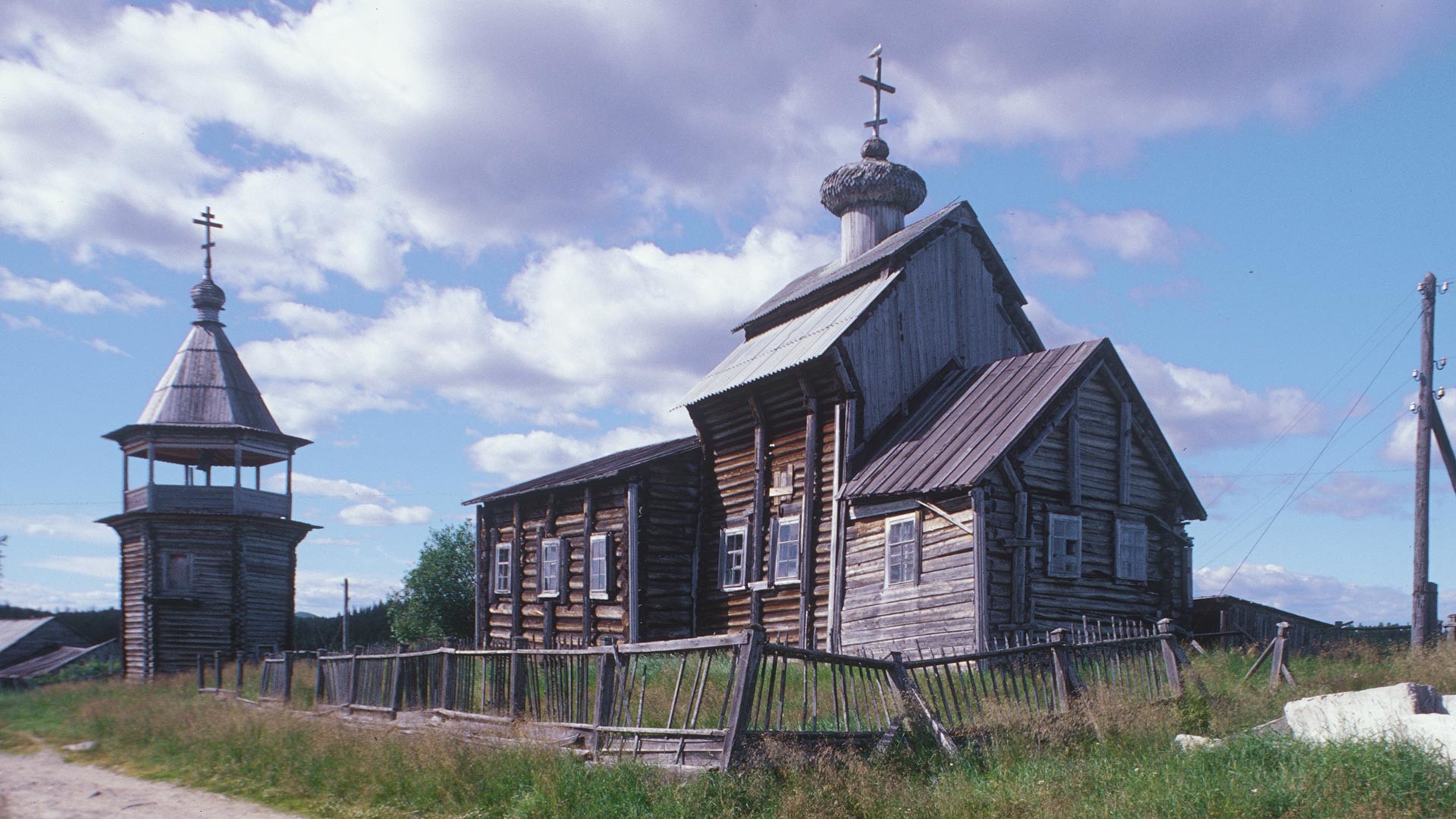
Kovda. Church of St. Nicholas, southeast view with bell tower. July 24, 2001
William Brumfield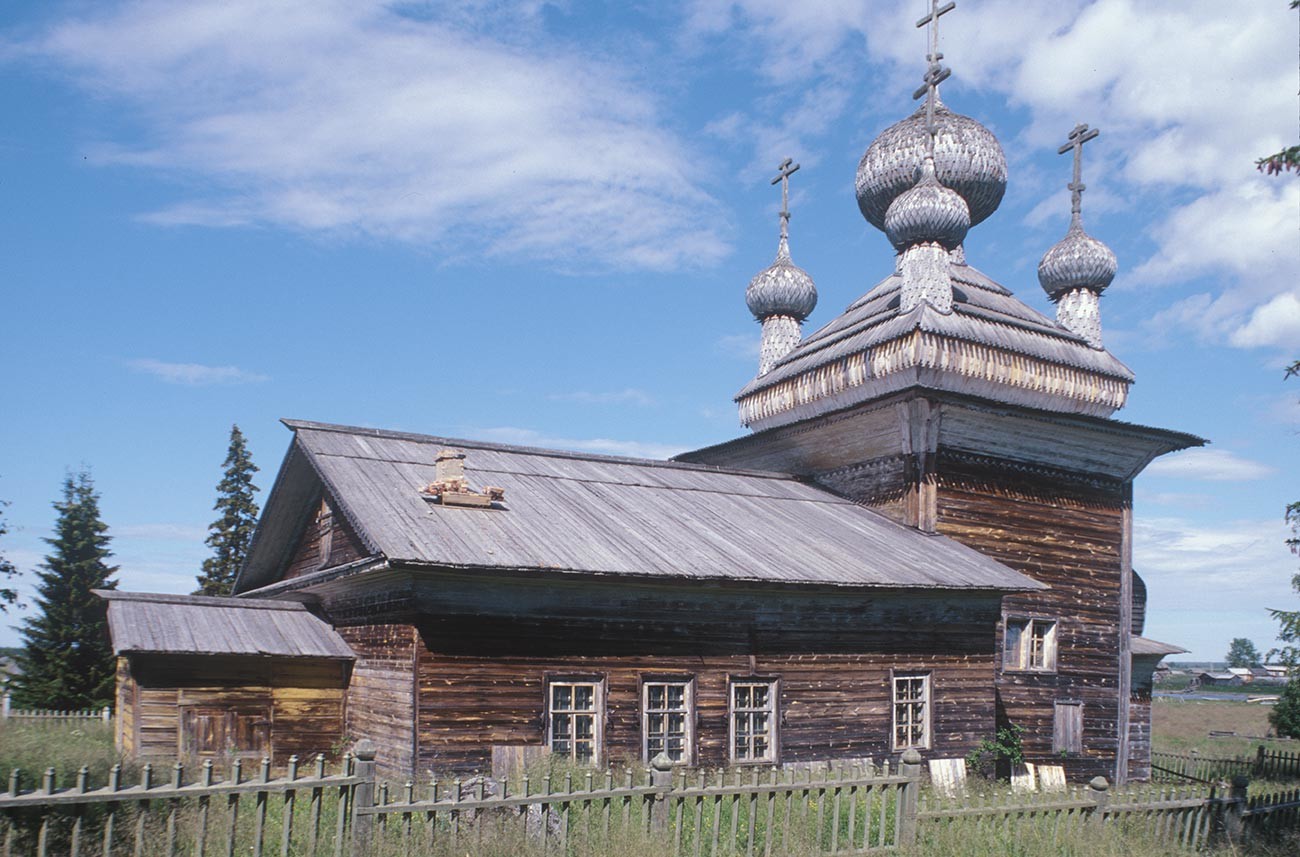
Virma. Church of Sts. Peter & Paul, south view. Right background: village houses & Virma River. July 7, 2000
William BrumfieldAt the beginning of the 20th century the Russian chemist and photographer Sergey Prokudin-Gorsky developed a complex process for vivid, detailed color photography (see box text below). Inspired to use this new method to record the diversity of the Russian Empire, he photographed numerous historic sites during the decade before the abdication of Nicholas II in 1917.
Prokudin-Gorsky’s final expedition took place in the historic Russian North during the late summer of 1916 as the Great War raged in Europe. His special passage during these difficult times was enabled by a state commission to photograph railroad construction north along the White Sea to the new port of Murman (now Murmansk), built to receive Western military supplies for the hard-pressed Russian armies.
The White Sea (Beloye More) is the primary geographical feature of the Russian North. For centuries, its natural bounty has supported those hardy souls willing to endure its severe climate. Its rocky western shore gave rise to fishing villages that provided sustenance to Russian settlers in this strategically important region.
Prokudin-Gorsky’s route in 1916 passed near ancient settlements along the western shore of the White Sea. My visit to this area occurred not quite a century later, in the summers of 2000 and 2001.
Soroka: Entrance to the White Sea
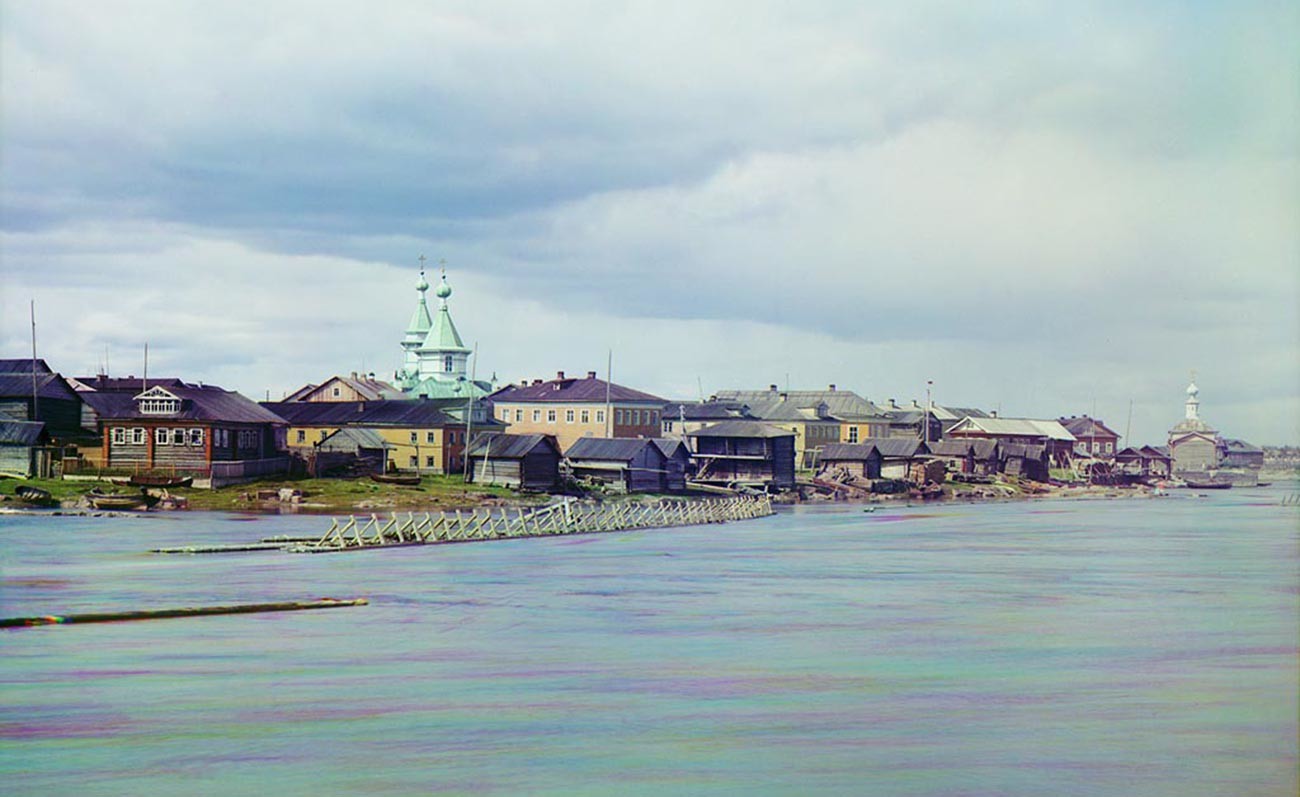
Soroka village (now Belomorsk) on Vyg River. Left: Church of the Trinity. Right: Church of Sts. Zosima & Savvaty (both demolished in 1939). Summer 1916
Sergey Prokudin-GorskyAmong these coastal settlements was the fishing village of Soroka, established as early as the 12th century and situated in what is now the Republic of Karelia. Its name, related to the Karelian word for island (soari), refers to its primary location on an island archipelago in the Vyg River estuary.
The Soroka village was evocatively photographed by Prokudin-Gorsky with full attention to its aquatic environment. Among the landmarks visible in his views are two wooden churches, one dedicated to the Trinity (1894) and the other dedicated in 1913 to Sts. Zosima and Savvaty, founders of the great Solovetsky Transfiguration Monastery nearby in the White Sea.
In the early 1930s, the settlement and its rail station played an important role in the construction of the White Sea-Baltic Canal (Belomorkanal), notorious for its use of forced labor. In recognition of its position as the northern terminus of the canal, the name was changed from Soroka to Belomorsk in 1938. The following year its two wooden churches were closed by state decree and destroyed soon after. In 2006, the Church of Sts. Zosima and Savvaty was rebuilt in a 19th-century style of wooden architecture.
Virma: Symbiosis of nature and faith

Virma. Church of Sts. Peter & Paul, west view. Log structure with plank siding. July 7, 2000
William BrumfieldAlthough the churches that Prokudin-Gorsky photographed in Soroka no longer exist, there are other log shrines in tiny villages along this stretch of the western shore of the White Sea. One of the most lyrical is the village of Virma, also dated to the 12th century and located in salt marshes near the mouth of the Virma River, 20 miles to the southeast of Belomorsk. The 2010 census gave Virma a population of 22 souls, and its few remaining wooden houses seem to float in the grassy marsh.
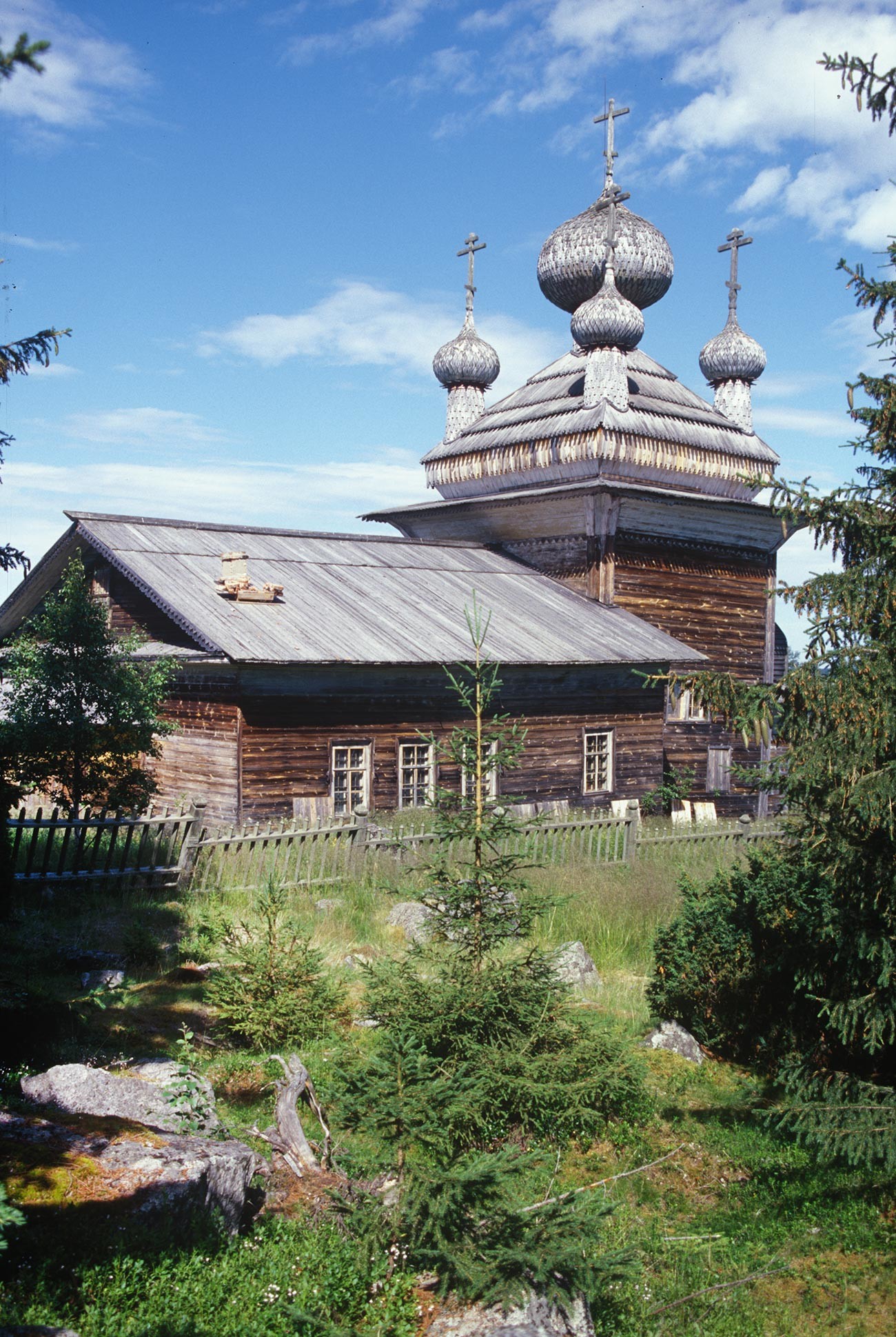
Virma. Church of Sts. Peter & Paul, southwest view. July 7, 2000
William BrumfieldLike other villages in the western part of the White Sea, Virma had for centuries been within the orbit of the powerful Solovetsky-Transfiguration Monastery. Although the relationship between the villages and the monastery was frequently contentious, the villages provided goods and labor, while the monastery attended to their spiritual needs. To this day. foundation traces remain of a salt refinery belonging to the monastery.
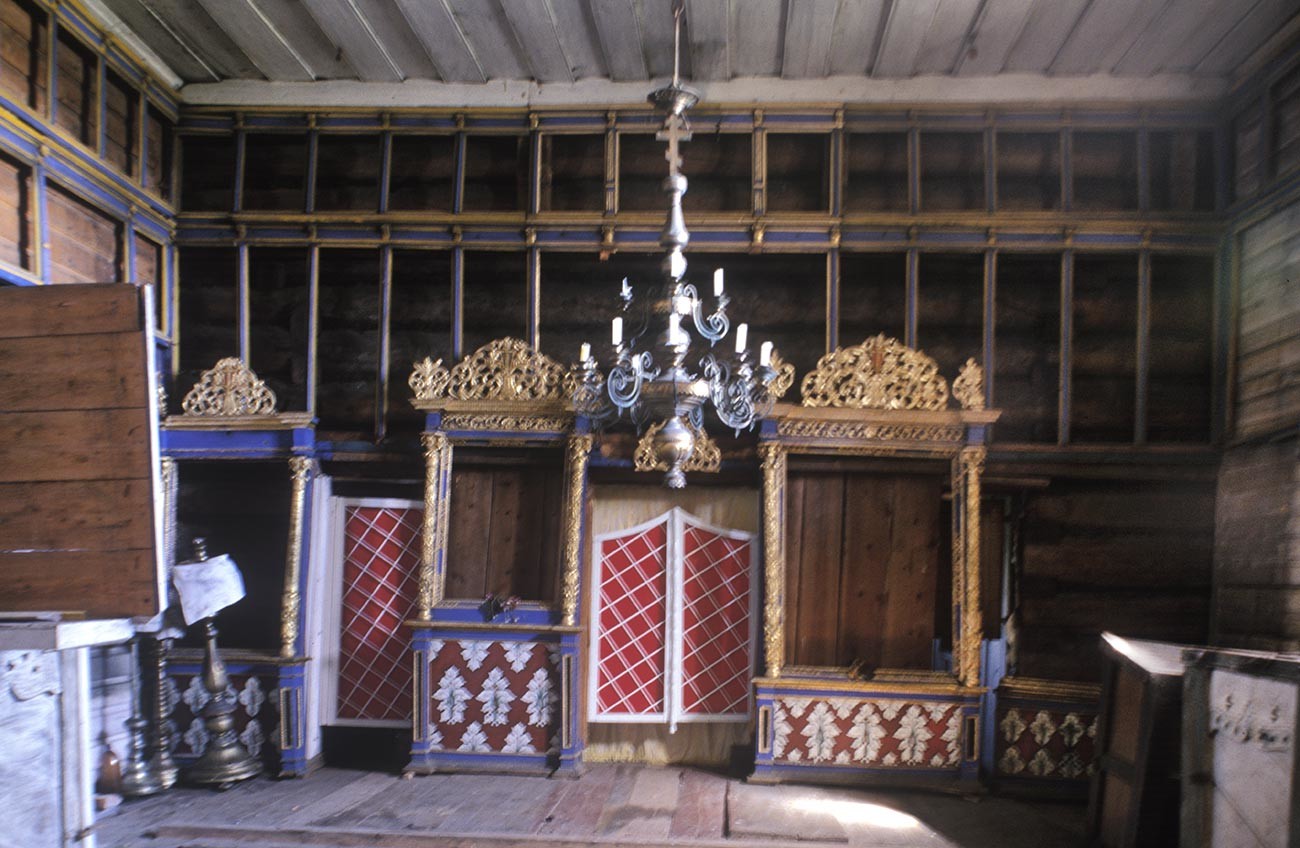
Virma. Church of Sts. Peter & Paul. Interior, view toward icon screen (icons removed during Soviet period). July 7, 2000
William BrumfieldThe dominant landmark in Virma is the village church, built perhaps as early as 1625 and rebuilt in 1759. Dedicated to Sts. Peter and Paul, the archaic structure rises like a living, organic form among the firs and other conifers that crowd the narrow coastline.
The Church of Sts. Peter and Paul has no bell tower. In compensation, however, it culminates in a remarkable array of five cupolas covered with silvery aspen shingles and surmounted with wooden crosses. This festive crown rests on a distinctive flared cuboid roof (called “kubovaty” in Russian) that is also clad in wooden shingles.
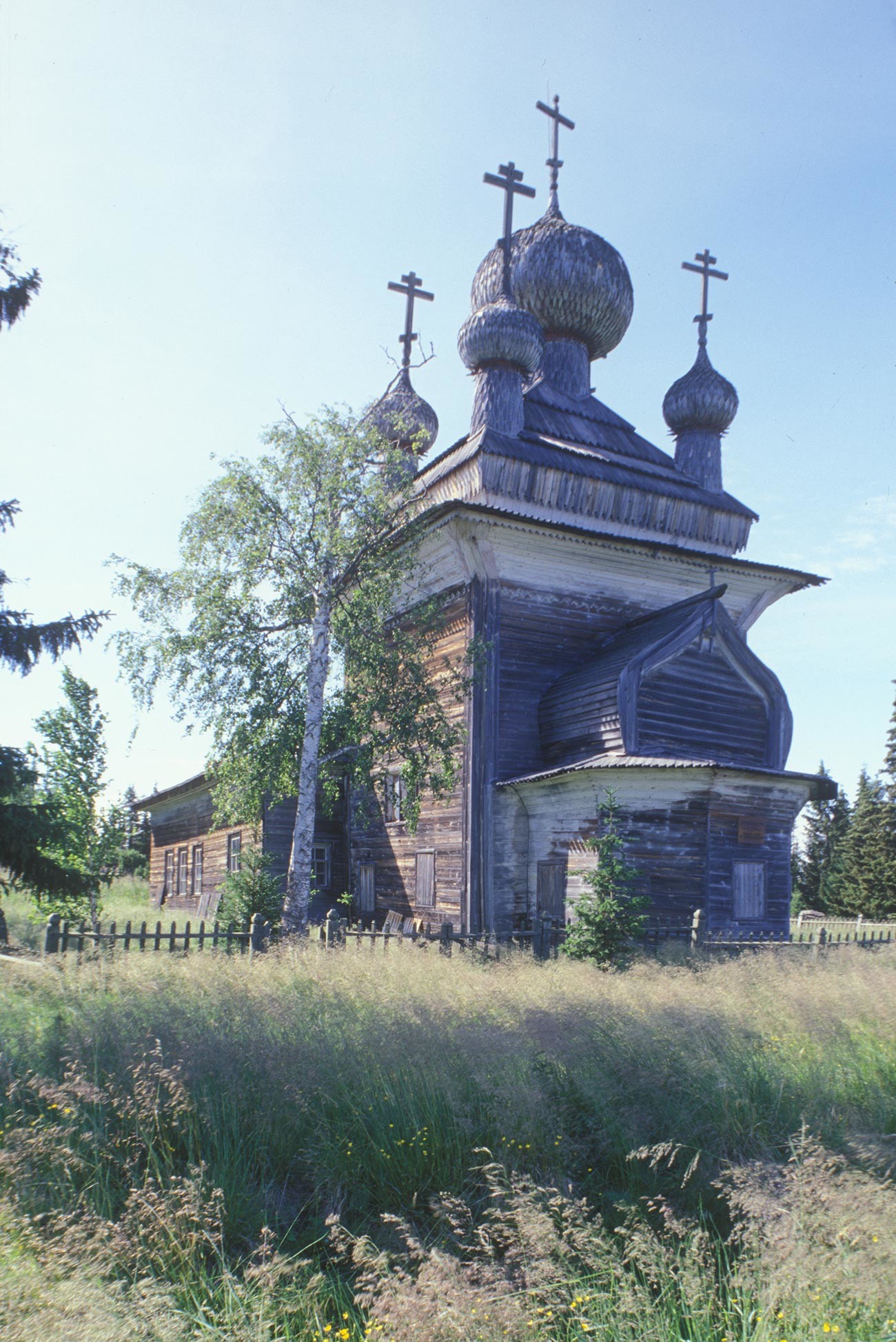
Virma. Church of Sts. Peter & Paul, southeast view with apse beneath "barrel" gable. July 7, 2000
William BrumfieldThe roof rests above the ledge of a projecting cornice that protects the log walls of the square main structure from excessive moisture. As in the best examples of Northern wooden architecture, function and beauty coexist in graceful harmony.
On the east is an apse crowned with the barrel gable, while the west part of the church consists of the usual low vestibule that could be heated for worship during the long winters. A small covered porch completes the linear design. When I was there in the summer of 2000, occasional worship services were held by a monk from the Transfiguration Monastery.
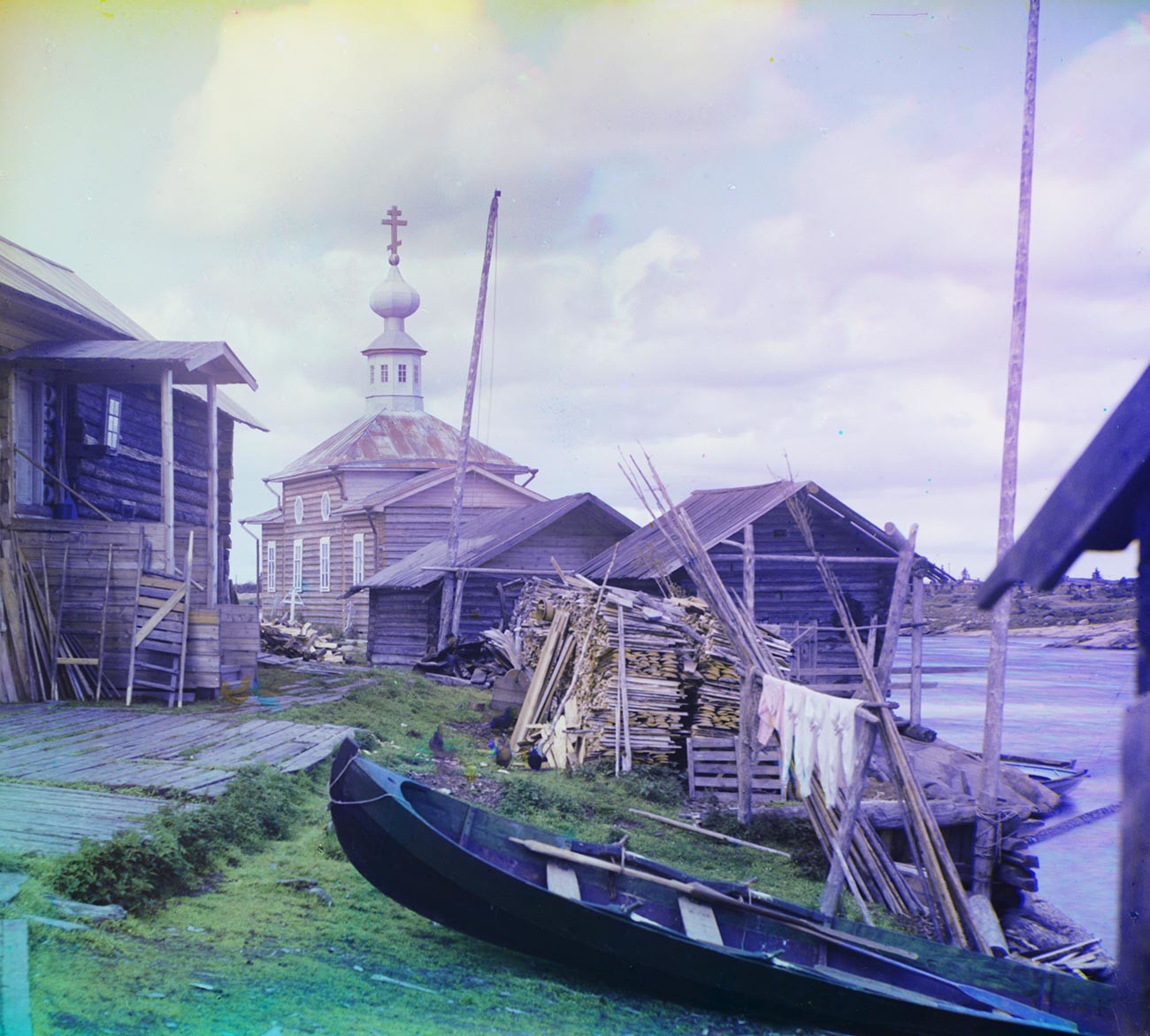
Soroka village (now Belomorsk). House overlooking Vyg River, with skiff, firewood & log sheds. Background: Church of Sts. Zosima & Savvaty. Summer 1916
Sergey Prokudin-GorskyKovda: Merging of land and sea
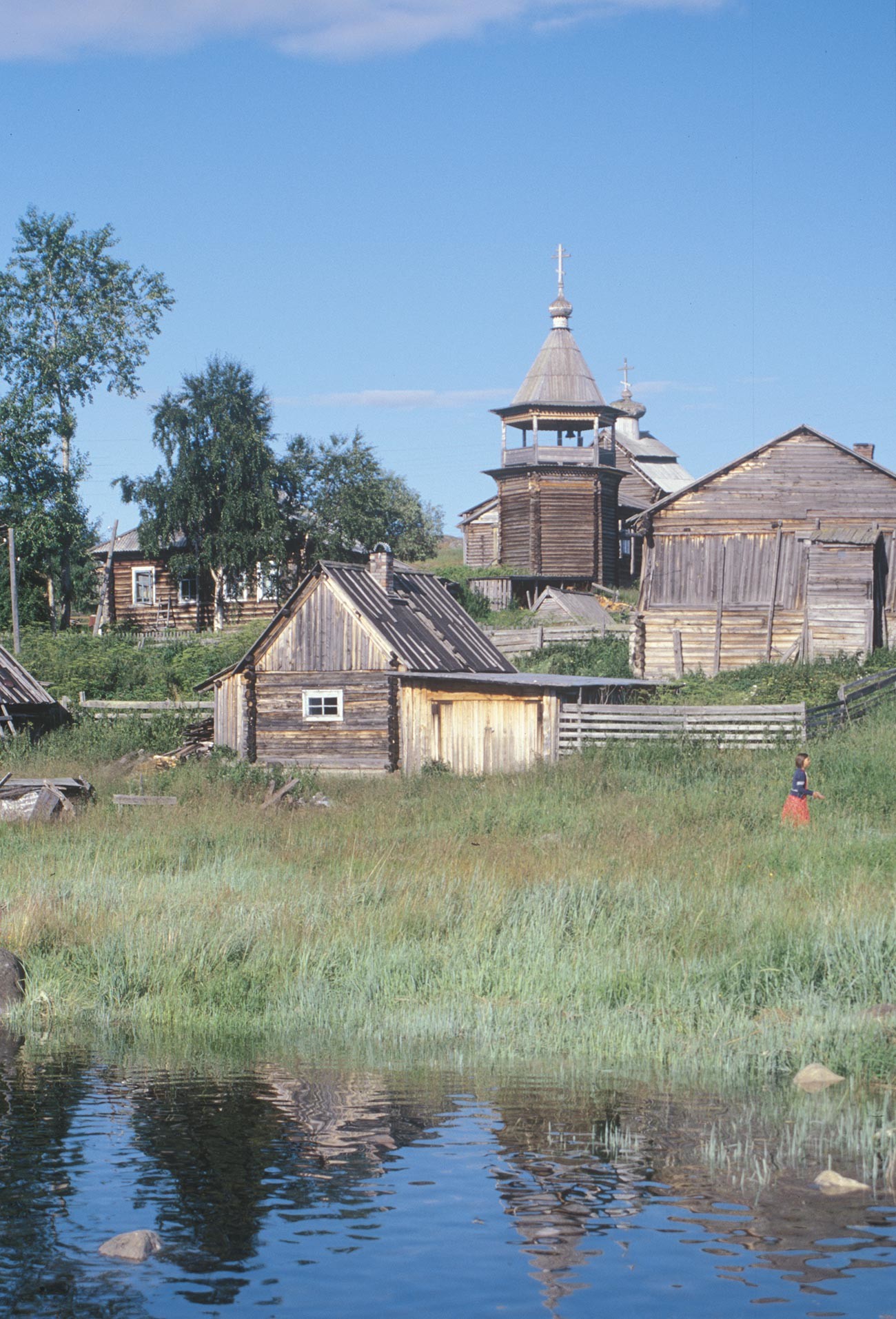
Kovda. Log house, bathhouse & barn. Background: bell tower & Church of St. Nicholas. July 24, 2001
William BrumfieldFarther north along the White Sea, coastal marshes give way to steep granite outcroppings overlooking bays and inlets. In such a dramatic setting, some 250 miles north of Virma, stands the village of Kovda with yet another miraculously preserved log church.

Kovda. Log houses overlooking Kandalaksha Bay. July 24, 2001
William BrumfieldKovda is located near Kandalaksha Bay, an arm of the White Sea that cuts into the southwestern part of Murmansk province. The village is perched on rocky cliffs above the point where the small Kovda River flows into the Startsev Inlet.
The population of Kovda in 2010 was officially listed as 20, less than half what it was when I was there a decade earlier. The scattered log houses that I photographed had carefully tended gardens carved into the hillside. Strings of dried fish, cured by the sun, were suspended along the sides of log walls. A log sheds and saunas complete the picture in this craggy yet stunningly beautiful landscape.
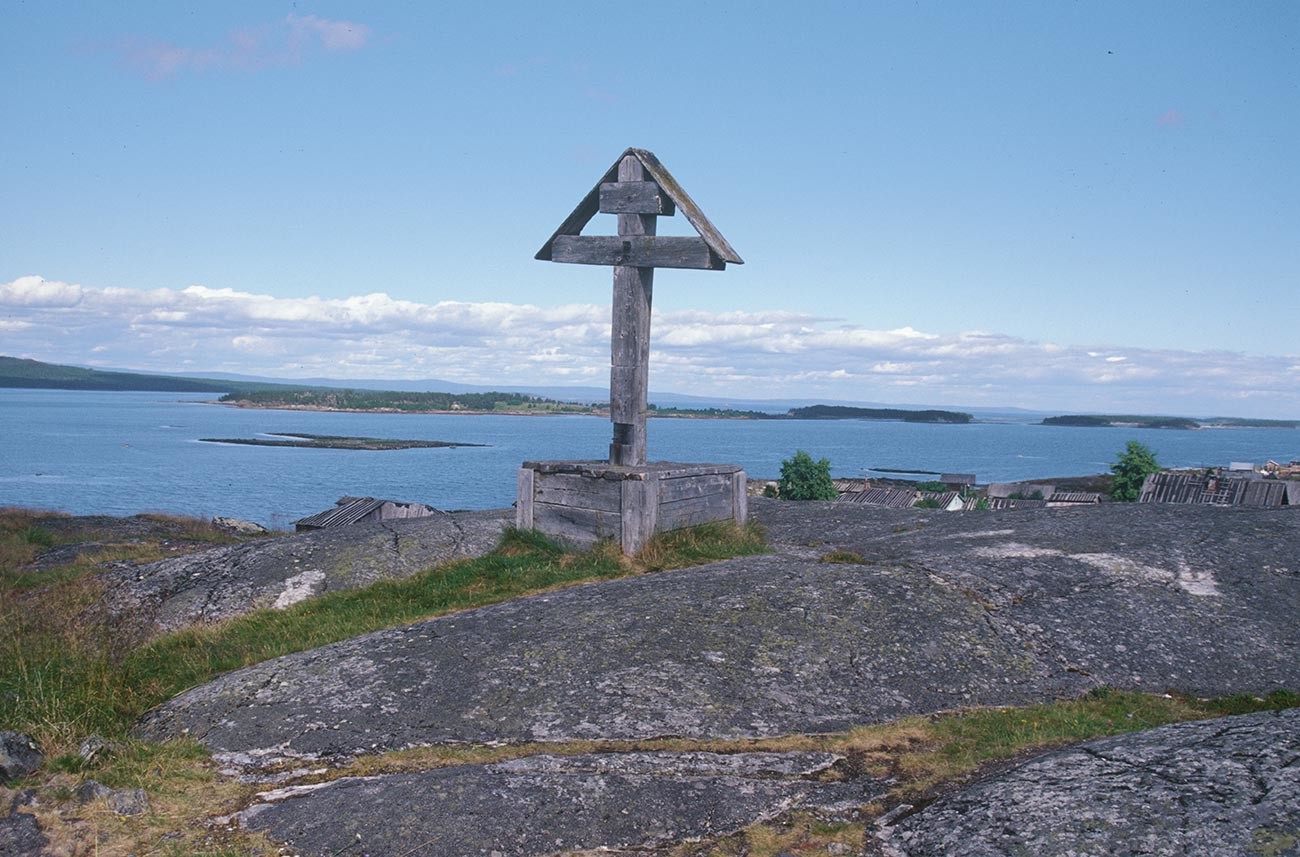
Kovda. Votive cross on granite outcropping overlooking Kandalaksha Bay. July 24, 2001
William BrumfieldAt the beginning of the 20th century, Kovda was a bustling commercial center, with a customs station, biological research station and a number of sawmills – including one English and another Swedish. Remnants of those enterprises survive in the neighboring settlement of Lesozavodsky (“Sawmill”) and Zelenoborsky. The completion of the Murmansk Railroad inland from Kandalaksha Bay diminished Kovda’s activity in favor of the railroad town of Kandalaksha, some 13 miles to the north.
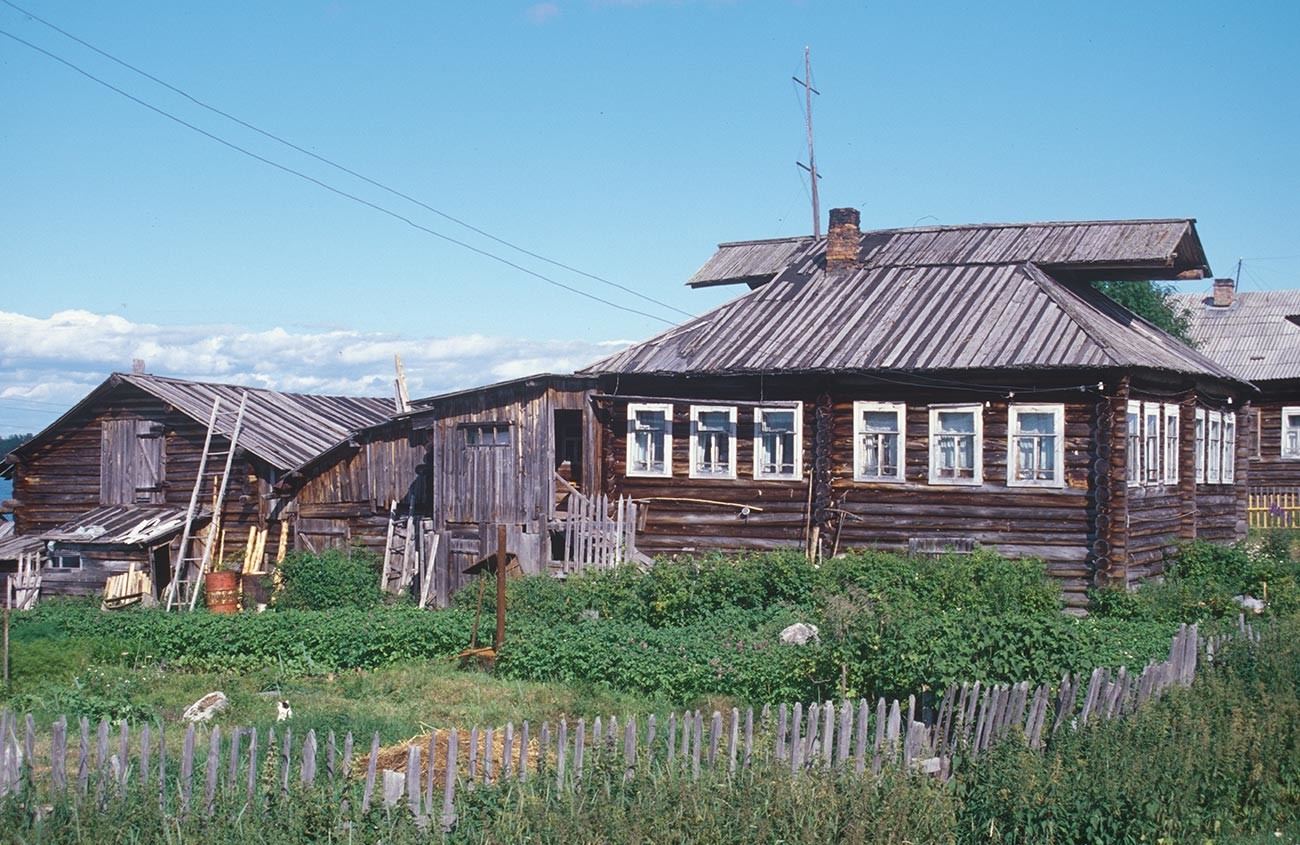
Kovda. Log house & barn. Note hooded gables on house roof. July 24, 2001
William BrumfieldAlthough Kovda dwindled, it retained its primary historical monument, the small log Church of St. Nicholas with its adjacent bell tower. A church had existed on the site as early as the 15th century, but the present structure has usually been dated to the beginning of the 18th century, when the bell tower was also built.
Recently, however, it has been proposed that the basic structure of the Kovda church dates to the end of the 16th century, following a devastating Swedish raid on the village. If the earlier date is accepted, the St. Nicholas Church would be the oldest surviving wooden church in the White Sea area.
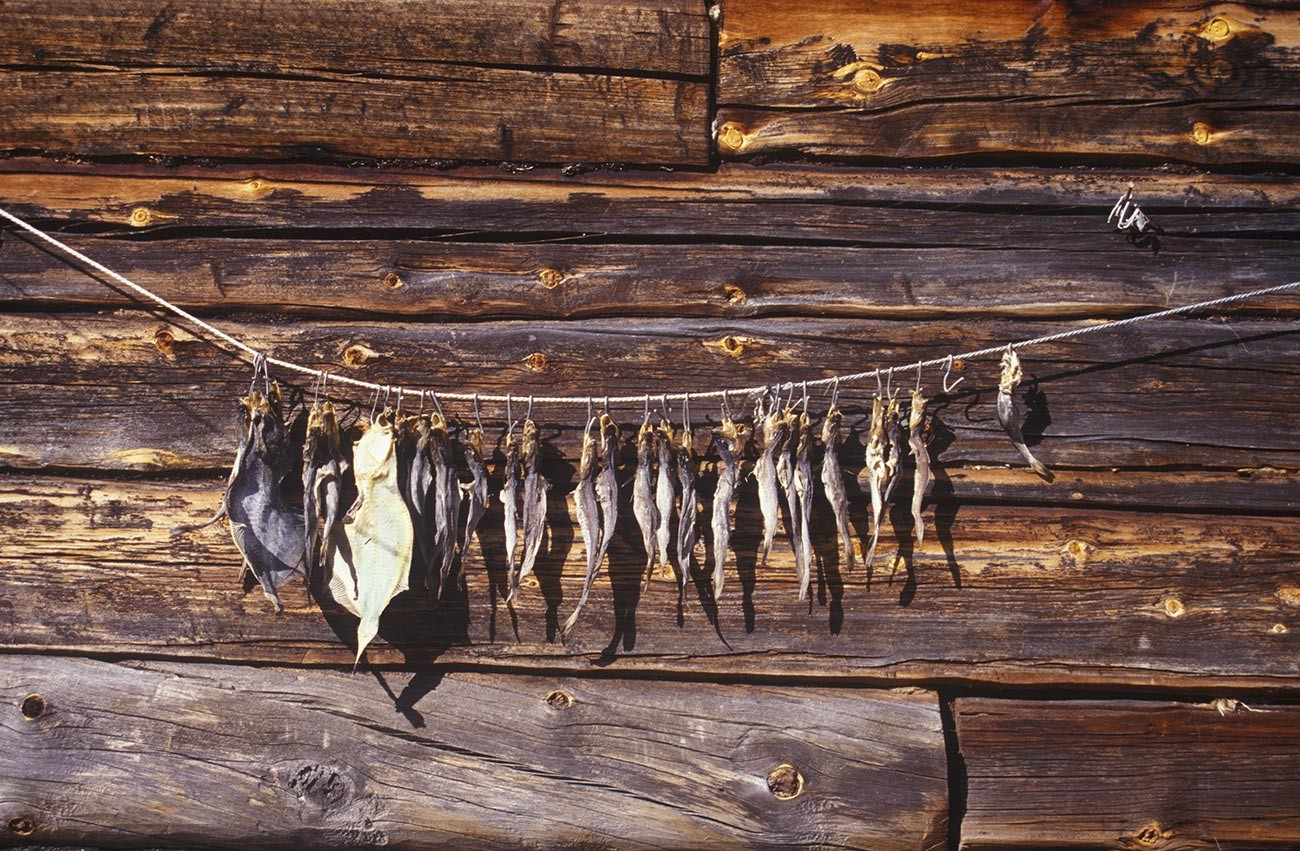
Kovda. Fish drying on side of log house. July 24, 2001
William BrumfieldWhatever the date, the plan of the basic structure is simple, with an apse containing the altar in the east. The main part is a square form with a double-pitched roof. At the top is an unusual squat cupola with a small nob supporting a cross.
The entrance to the St. Nicholas Church is through a vestibule added to the western side of the main structure apparently in the mid-18th century. The two components are not connected structurally in this archaic design. The vestibule is wider than the central component and built of thicker logs. The church ensemble was earlier surrounded by a cemetery enclosed with a low log wall.
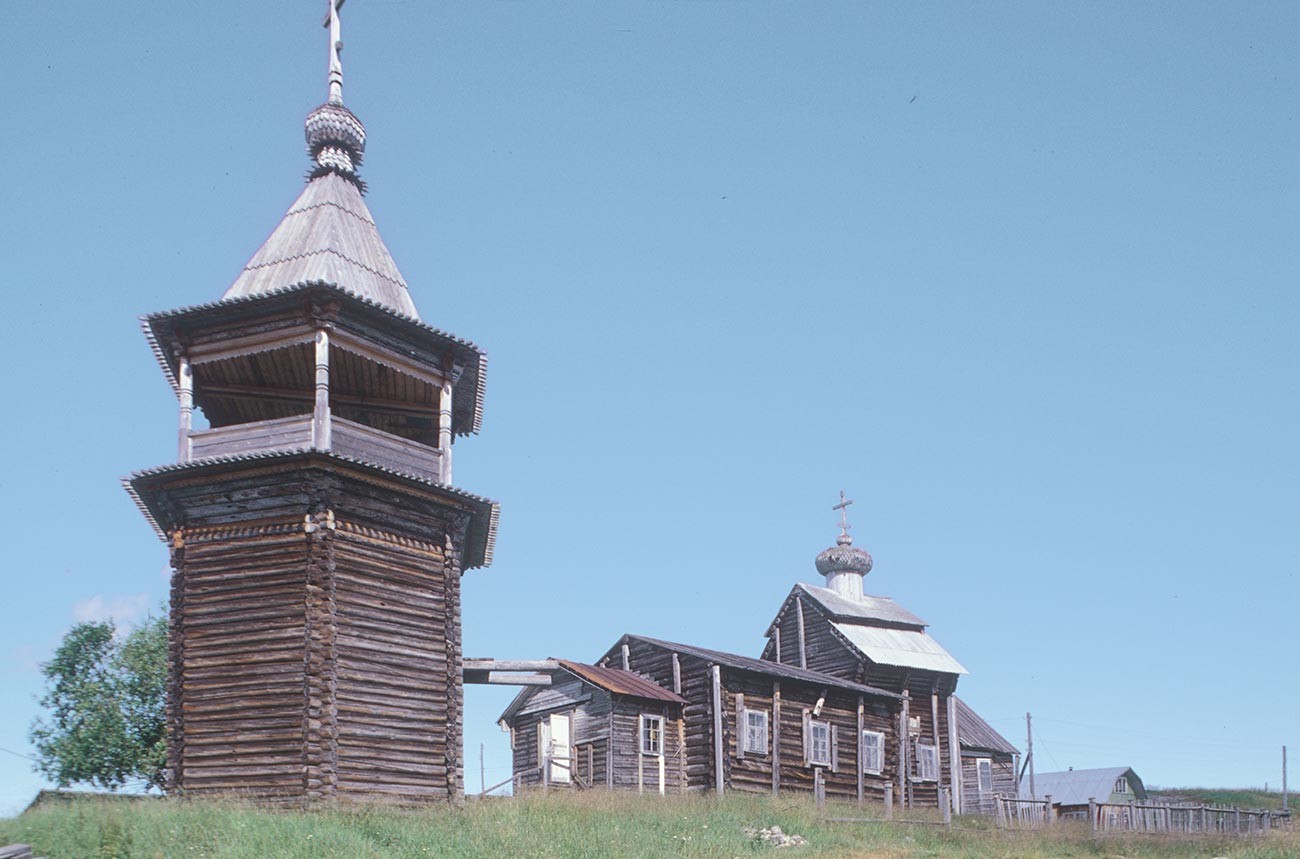
Kovda. Bell tower & Church of St. Nicholas, southwest view. July 24, 2001
William BrumfieldLike most wooden churches in the 19th century, the St. Nicholas Church was clad in plank siding, examples of which are seen in Prokudin-Gorsky’s photographs throughout this region. The siding was removed as part of the preservation attempt during the Soviet period.

Kovda. Church of St. Nicholas, west view from bell tower. July 24, 2001
William BrumfieldClosed in 1960, the Kovda church was finally slated for restoration as a cultural monument in the 1990s. The bell tower was rebuilt in a simplified form, and restoration of the church itself began in 2003, albeit with frequent halts and disputes over the proper form.
The St. Nicholas Church at Kovda now has artificial-looking siding, but at the beginning of this century I was able to photograph the original log structure. Quite apart from the church, the physical setting of Kovda is an astonishing, spiritual merger of land and sea.
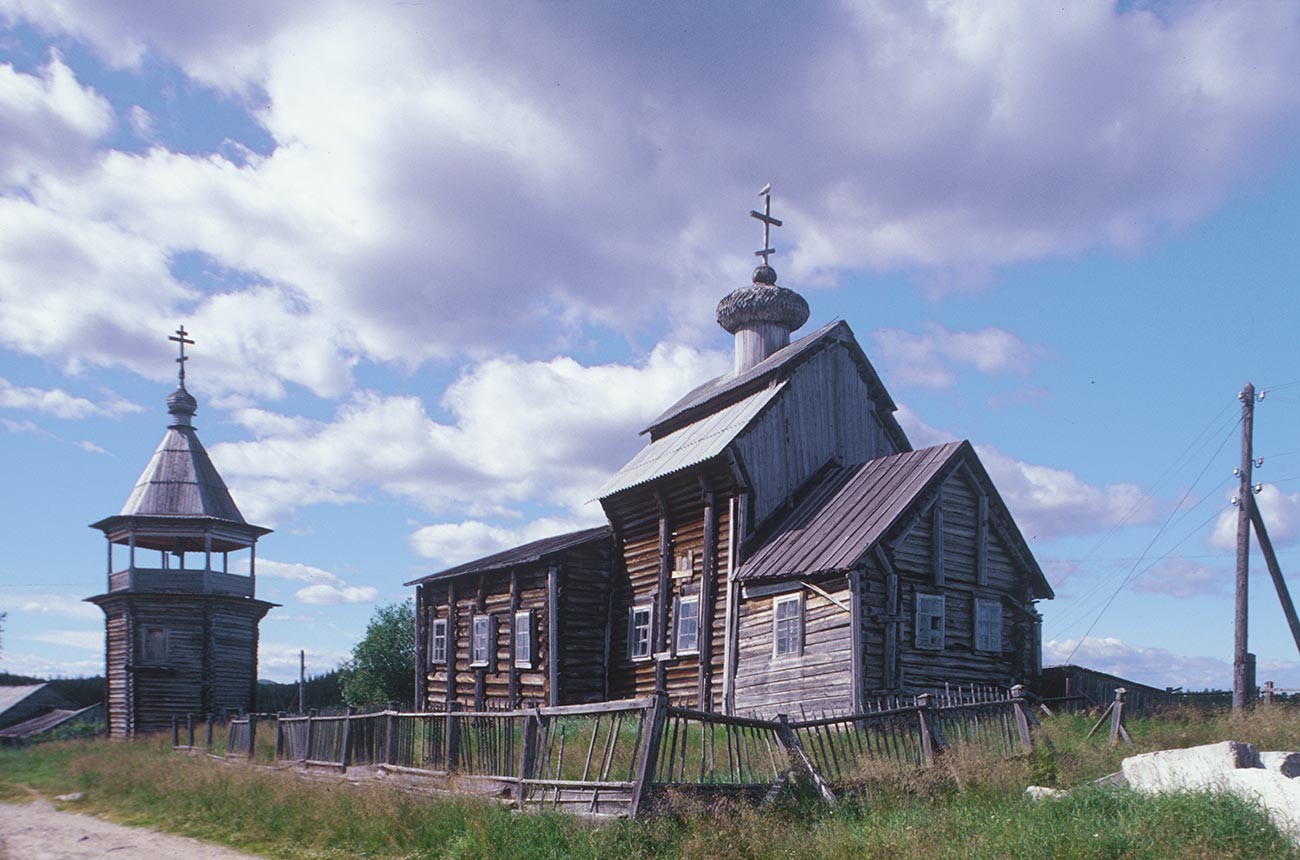
Kovda. Church of St. Nicholas, southeast view with bell tower. July 24, 2001
William BrumfieldIn the early 20th century, the Russian photographer Sergey Prokudin-Gorsky developed a complex process for color photography. Between 1903 and 1916 he traveled through the Russian Empire and took over 2,000 photographs with the process, which involved three exposures on a glass plate. In August 1918, he left Russia and ultimately resettled in France where he was reunited with a large part of his collection of glass negatives, as well as 13 albums of contact prints. After his death in Paris in 1944, his heirs sold the collection to the Library of Congress. In the early 21st century the Library digitized the Prokudin-Gorsky Collection and made it freely available to the global public. A few Russian websites now have versions of the collection. In 1986 the architectural historian and photographer William Brumfield organized the first exhibit of Prokudin-Gorsky photographs at the Library of Congress. Over a period of work in Russia beginning in 1970, Brumfield has photographed most of the sites visited by Prokudin-Gorsky. This series of articles juxtaposes Prokudin-Gorsky’s views of architectural monuments with photographs taken by Brumfield decades later.
If using any of Russia Beyond's content, partly or in full, always provide an active hyperlink to the original material.
Subscribe
to our newsletter!
Get the week's best stories straight to your inbox